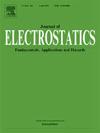Trap energy distribution in aircraft dielectric materials through surface potential decay method
IF 2.1
4区 工程技术
Q3 ENGINEERING, ELECTRICAL & ELECTRONIC
引用次数: 0
Abstract
Charge deposition on aircraft insulation material surfaces is challenging to discharge via electrostatic discharger, potentially leading to streamer discharge and interference with avionic systems. To mitigate this risk and enhance flight safety, a quantitative understanding of charge trap distributions in these materials is essential. Three common aircraft dielectric materials—fiberglass epoxy, silicon carbide, and epoxy resin—were selected to conduct surface potential decay experiments. By systematically analyzing the potential decay characteristics of these materials under two corona charging polarities, their electron and hole trap distribution parameters were accurately determined. The results demonstrate that fiberglass epoxy exhibits predominant deep traps (1.025 eV) for both electrons and holes with high density (>7 × 1019 m−3), leading to significantly slower potential decay (τ10 % > 7000 s) and stronger charge binding capacity. Silicon carbide possesses dominant shallow electron traps (0.95 eV, 1.8 × 1020 m−3) resulting in faster decay (τ10 % < 2000 s). Epoxy resin also features primarily shallow traps for both carriers (0.93–0.96 eV), with decay times exceeding 3200 s. These distinct trap distribution characteristics (energy, density, and dominance of shallow/deep levels) arise from inherent material microstructural differences (e.g., polar groups, crystalline defects, interfacial structures) and directly govern their charge accumulation and dissipation dynamics in specific aircraft applications (radomes, engine components, structural parts). The findings provide quantitative data for optimizing aircraft dielectric material selection and electrostatic protection design.
利用表面电位衰减法捕获飞机介质材料中的能量分布
飞机绝缘材料表面的电荷沉积是一项具有挑战性的静电放电技术,可能导致流带放电并干扰航空电子系统。为了减轻这种风险并提高飞行安全,定量了解这些材料中的电荷陷阱分布是必不可少的。选取三种常用的飞机介质材料——玻璃纤维环氧树脂、碳化硅和环氧树脂进行表面电位衰减实验。通过系统分析这些材料在两种电晕充电极性下的电位衰减特性,准确确定了它们的电子和空穴阱分布参数。结果表明,玻璃纤维环氧树脂在高密度(>7 × 1019 m−3)的电子和空穴中均表现出明显的深阱(1.025 eV),从而显著减缓了电位衰减(τ 10% > 7000 s)和更强的电荷结合能力。碳化硅具有优势的浅电子陷阱(0.95 eV, 1.8 × 1020 m−3),导致更快的衰变(τ 10% < 2000 s)。环氧树脂还主要具有两种载流子(0.93-0.96 eV)的浅阱,衰变时间超过3200秒。这些不同的陷阱分布特征(能量、密度和浅/深能级的优势)源于固有的材料微观结构差异(例如,极性基团、晶体缺陷、界面结构),并直接控制着它们在特定飞机应用(天线罩、发动机部件、结构件)中的电荷积累和耗散动力学。研究结果为优化飞机介质材料选择和静电防护设计提供了定量数据。
本文章由计算机程序翻译,如有差异,请以英文原文为准。
求助全文
约1分钟内获得全文
求助全文
来源期刊

Journal of Electrostatics
工程技术-工程:电子与电气
CiteScore
4.00
自引率
11.10%
发文量
81
审稿时长
49 days
期刊介绍:
The Journal of Electrostatics is the leading forum for publishing research findings that advance knowledge in the field of electrostatics. We invite submissions in the following areas:
Electrostatic charge separation processes.
Electrostatic manipulation of particles, droplets, and biological cells.
Electrostatically driven or controlled fluid flow.
Electrostatics in the gas phase.
 求助内容:
求助内容: 应助结果提醒方式:
应助结果提醒方式:


